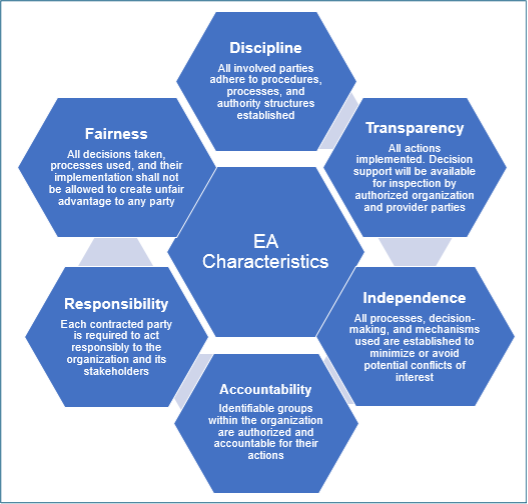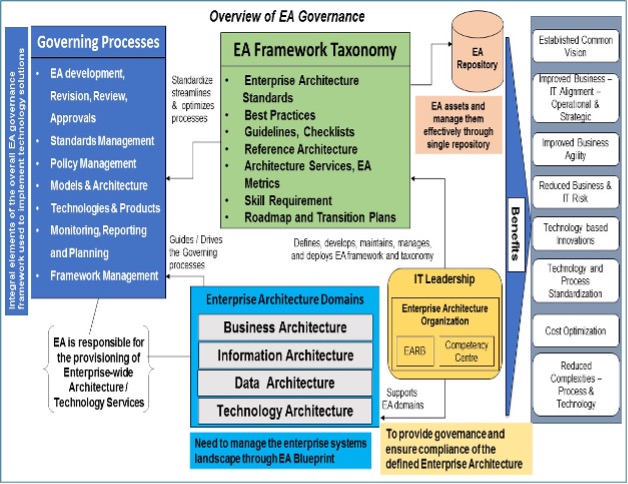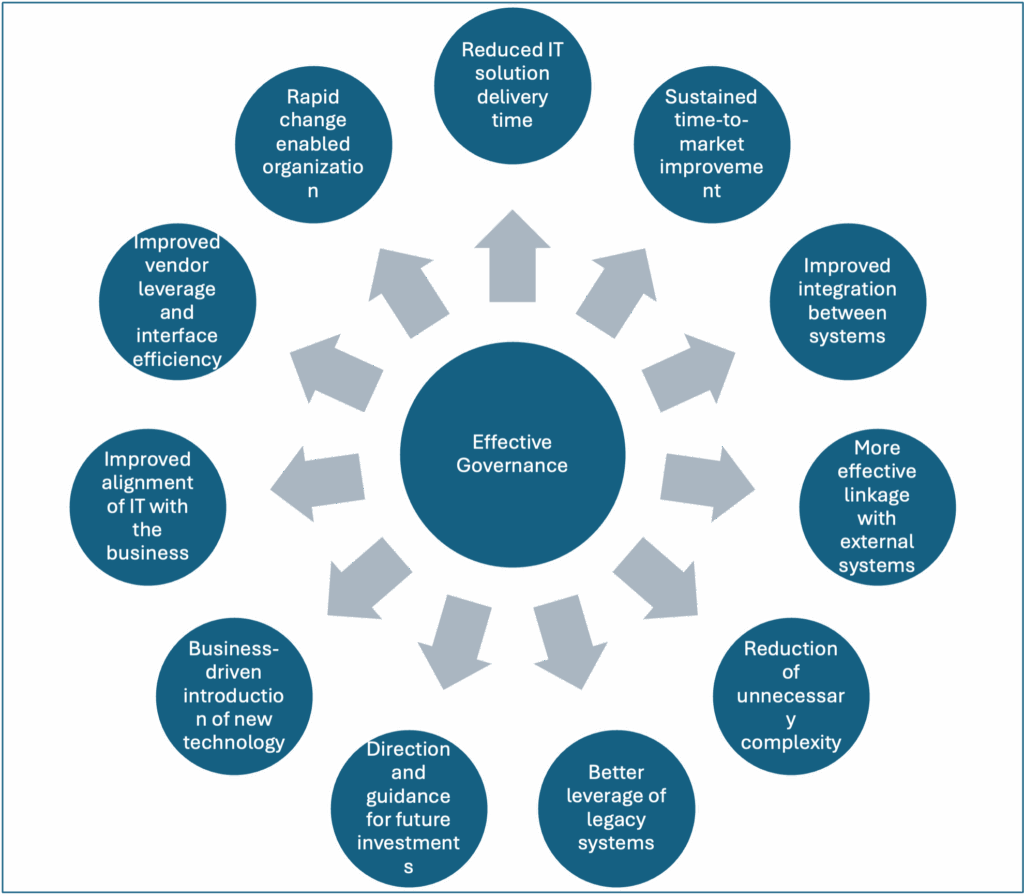
(Editor’s Note: This is Part 2 of Enterprise Architecture Governance – Why It Is Important, written by Dr. Gopala Krishna Behara. Part 1 published Wednesday, August 18.)
EA GOVERNANCE FRAMEWORK
A sound governance framework to support implementation and management of the enterprise architecture is necessary to ensure that enterprise achieves its EA objectives.
The following characteristics highlight the considerations for developing governance as an approach to adopt within the EA initiative:

Fig : EA Governance Characteristics
Embodying these characteristics, EA Governance will not be an isolated discipline; rather it will operate within the hierarchy of other governance structures existing within enterprise.
EA Governance comprises the enterprise structure and a set of policies, processes, and procedures, by which the enterprise can control the IT solutions, as well as deploy to ensure that they are consistent with the EA vision, principles, and standards.
The EA Governance Framework comprises the following elements required in maintaining enterprise architecture:
- EA Governance Organization Structure
- EA Review Board
- EA Governance Processes
- EA Taxonomy
- EA Repository
- EA Metrics

Fig : EA Governance Framework
EA ORGANIZATION STRUCTURE
The Enterprise Architecture organization helps to develop and enable the adoption of design, review, execution and governance capabilities around EA.
EA guidance and governance over the Enterprise IT solutions delivery processes focused on realizing a number of solutions characteristics. These include:
- Standardization: Development and promotion of enterprise-wide IT standards.
- Consistency: Enable required levels of information, process and applications integration and interoperability.
- Reuse: Strategies and enabling capabilities that enable reuse and advantage of IT assets at the design, implementation and portfolio levels. This could include both process/governance and asset repository considerations.
- Quality: Delivering solutions that meet business functional and technical requirements, with a lifecycle management process that ensure solutions quality.
- Cost-effectiveness and efficiency: Enabling consistent advantage of standards, reuse and quality through repeatable decision governance processes enabling reduced levels of total solutions lifecycle cost, and enabling better realization on IT investments.
The EA group is responsible for overall architecture planning and oversight, including the review of technology plans, establishing standards and guidelines, providing directional input into the enterprise-wide technology plan, and reviewing technology acquisitions. Generally, the EA Chief Architect reports to the CIO, and the EA group provides guidance to the IT Leadership.
Enterprise IT Leadership: It comprises of executive management including CIO & business executives and would define the enterprise strategic elements and coordinate with program management office and EARB to translate these elements to procedural elements. The following are the responsibilities of Enterprise IT Leadership Council:
- Managing the enterprise business portfolio along with CIO
- Formulating enterprise business strategies along with CIO
- Setting enterprise strategic directions and priorities on how IT will be used to enable the business
- Collaborating with EA workgroup to apply due diligence across the project portfolio
- Collaborating with EA Competency Center to develop common enterprise-wide technology visions and requirements
EA Review Board: The core EA Review Board comprising different architects. The primary responsibility of this body is to participate in key activities like architectural reviews, project prioritization and approvals, RFP/Vendor evaluation and process reviews. This body should also ensure compliance of defined standards and processes. The following section explains the details of EA Review Board and its roles and responsibilities. The Governance responsibilities are,
- Providing a mechanism for the formal acceptance and approval of architecture through consensus and authorized publication
- Providing a control mechanism for ensuring the effective implementation of the architecture
- Establishing and maintaining the link between the implementation of the architecture, the architectural strategy and objectives embodied in the enterprise architecture, and the strategic objectives of the business
- Identifying divergence from the architecture and planning activities for realignment through dispensations or policy updates
EA Competency Center: The EA Competency Center will keep a close watch on new technology evolution in the marketplace and determines the business value that is generated from them for the enterprise. It helps developing tools, processes and migration methodologies that help moving the old systems on to new technologies & platforms. Based on the business value that a particular technology brings, technology office can suggest IT Leadership council to start new competency centers.
EA GOVERNANCE PROCESSES
The Enterprise EA Governance Framework manages all content relevant both to the architecture itself and to architecture governance processes.
The architecture lifecycle processes are integral elements of the overall EA governance framework used to implement technology solutions within Enterprise. Listed below are the five primary processes:
- Architecture Documentation Process, architecture documentation process describes the systematic process for developing and maintaining the EA framework
- Architecture Review Process, ensure consistency with enterprise IT eco-system. Ensure all the architecture decisions are taken with valid reasons
- Architecture Communication Process, ensure the EA framework contents communicated in a timely and accurate manner. Without a thorough communication process, the enterprise architecture is simply a document, providing no real substance to Enterprise
- Architecture Compliance Process, describe the process to request a variance from the product or compliance components approved within Enterprise. Having an established architecture compliance process is an appropriate and tactically sound approach to managing information technology from an enterprise perspective.
- Architecture Framework Vitality Process, insure the content of the EA framework remains current and accurate. This is a major requirement of the governance processes.
EA TAXONOMY
Taxonomy is a collection of defined terminology, and a coherent description of the components and the conceptual structure of architecture.
- Foundation components: provides a basis to the supporting and canonical components, based on industry de facto principles in EA, and the corporate IT environment and culture at enterprise. The taxonomy structure is governed by EA Governance, which links up with IT Governance. Guiding Principles are the key element in this area.
- Supporting components: based on the Foundation components and based on industry de facto practices and guiding principles with respect to the enterprise culture and IT environment. Approaches, Best Practices, Methodologies, Metrics, and Protocols are the key elements in this area.
- Canonical components: based on industry de facto definitions in reference architectures, IT processes, and architecture standards, and supporting framework components at enterprise. Processes, Standards and Blueprints are the key elements in this area.
Specific definitions for key concepts and terms listed below.
Approach is a way in which a task, activity, or process is executed and in which the performance is measured to meet the criteria covering principles, policies, systems, processes, approaches, and techniques.
Best Practice is a way or method of accomplishing a business function or process that considered superior to all other known methods.
Blueprints –
- Plan or guide, commonly used in construction, laid out logically and including essential elements to address and follow as building progress
- A blueprint is a plan or design documenting architecture of enterprise
Guiding Principles – Principles are general rules and guidelines, intended to be enduring and seldom amended, that inform and support the way in which an organization sets about fulfilling its mission.
Methodologies – A methodology represents a package of practical ideas and proven practices for a given area of activity, such as the planning, design development or management of IT-based systems
Processes – Process is a sequence of operations or events, possibly taking up time, space, expertise or other resources, which produces specific outcomes.
Protocols –
- Rules governing transmitting and receiving of data.
- Follow standard that specifies the format of data and rules in data communication and network environments.
- Rules of engagement between various roles while performing a function or service.
Standards – A set of criteria (some of which may be mandatory), voluntary guidelines, and best practices. The EA guidelines and standards are,
- Architecture must be appropriately scoped, planned, and defined based on the intended use of the architecture. Development and promotion of enterprise wide standards
- Enterprise architecture must reflect Organization strategic plan
- Architecture continuously changes and requires transition
- Architecture must allow many disparate hardware and software systems to connect and integrate with each other. They need to exchange data to perform the desired business transactions.
- Enterprise Architecture will need to continue refreshing and updating the framework as well as the taxonomy, and to improve the enterprise architecture model.
- Enterprise IT must provide policy guidance, assistance in the definition, design, implementation of Architecture discipline and practice throughout the organization
- Enabling consistent advantage of standards, reuse and quality through repeatable decision processes enabling reduced solutions cost, and enabling better realization on IT investments.
- Strategies to enable capabilities that reuse and leverage IT assets at the design, implementation and portfolio levels. This could include process/governance and asset repositories.
EA METRICS
To ensure that EA is progressing well, and adding value to the organization, there is a need to define metrics for measuring effectiveness of it. However, EA metrics is still an emerging field and there are no defined standards. In addition, current literature does not contain a tool to measure the success of EA implementation.
EA effectiveness is the degree to which the objectives of EA are being attained by means of EA. EA Metrics not only helps in gauging the long term impact of EA, but also helps in measuring the true value of EA which will enable the Organization to plan more effectively and efficiently.
Measuring an EA metrics is necessary to,
- Determine how effectively and efficiently the process or service satisfies the customer
- Improved ability to seize new business opportunities
- Make decisions based on FACT and DATA
- Improved agility
- Ability to extend systems to meet increasing demand
- Better ability to outsource
Measurement should,
- Translate customer expectations into goals
- Evaluate the quality of processes
- Track improvements
- Support enterprise strategies
EA REPOSITORY
EA tools provide support for strategic decision making by capturing vital enterprise context, along with content development and analysis capabilities across the business, information, technology and solution architectures.
It helps the stakeholders to analyze and optimize the portfolio of business strategies, organizational structures, business processes / tasks and activities, information flows, applications, and technology infrastructure.
EA GOVERNANCE BENEFITS
Effective Governance provides the following benefits at the enterprise Level,

Fig : Benefits of EA Governance
Significant cost savings are achieved with right governance model in enterprise, in addition to the following benefits:
- Brings clarity in roles and responsibilities through management oversight.
- Facilitates clear and quick decision making on contentious issues by bringing in transparency and accountability.
- Preserves architectural coherence by weaving in a compliance culture.
- Keeps architecture relevant and useful in a pragmatic manner.
- Elevates the role of and accentuates visibility accorded to architecture within the enterprise
- Expedites adoption of architecture thinking in the organization
- Ensures that architecture efforts expended in the right activities.
- Sets focus on performance improvement leading to attainment of best practices.
CONCLUSION
In summary, a well-designed Enterprise Architecture governance structure can be an essential tool in reducing IT cost and risk and accelerating in decision-making and delivery. EA Governance ensures that the EA program is properly managed, and it produces artifacts and plans that are truly representative of organizational goals and needs. It ensures, the Investment decisions are aligned with the EA from initiation to implementation.
Governance is an important part of any change initiative and EA is no exception. Governance provides a platform for various stakeholders to interact regularly and maintain the enterprise architecture. Without adequate governance, Enterprise Architecture will remain a theoretical concept that will fail to deliver the desired business benefits.
In addition, EA program definition should not span for years. It should deliver business value in ashort time. In addition, the program output should be actionable as well as always measure impact, but not activity.
In modern EA, the Ivory Tower approach of EA Governance will not work. This causes EA programs to fail, especially when the EA program does not consider the demands of digital business, driven by a shift in value creation to ecosystems, platforms and outside-out architecture.
The role of EA Governance in digital business is summarized below,
- Do not focus on Current State Architecture
- Continue to advance EA program to the next level of maturity
- Understand organization’s business strategy, business models and goals, and determine how EA can help deliver business value
- Don’t get distracted by EA frameworks, industry reference models, governance and EA tools
- Shift Emphasis from Top-Down Governance to an EA Center of Excellence
- Adopt a continuous innovation approach to EA program, refine each cycle
- Don’t purchase EA Tool, without understanding the use cases and Capabilities
Dr.Gopala Krishna Behara is a Distinguished Member and Lead Enterprise Architect in Wipro Technologies with 25+ years of extensive experience in the ICT industry. He serves as an Advisory Architect, Mentor on Enterprise Architecture, Application Modernization and continues to work as a Subject Matter Expert and Author. He is certified in Open Group TOGAF, AWS Solution Architect -Associate, IBM Cloud Solutions and UNPAN. Published number of research papers, books in IT industry. He has been a speaker at National and International forums and bodies like The Open Group, National e-Governance Forum. He has been a moderator and panel member for multiple technical/business forums like IGI Global, AEA, Open Group and Premium College meets. Recipient of EA Hall of Fame International Award – Individual Leadership in EA Practice, Promotion and Professionalization Award. He can be reached at gopalakrishna.behara@gmail.com
The views expressed in this article/presentation are that of authors and Wipro does not subscribe to the substance, veracity or truthfulness of the said opinion.
